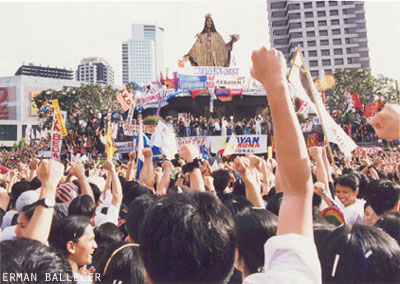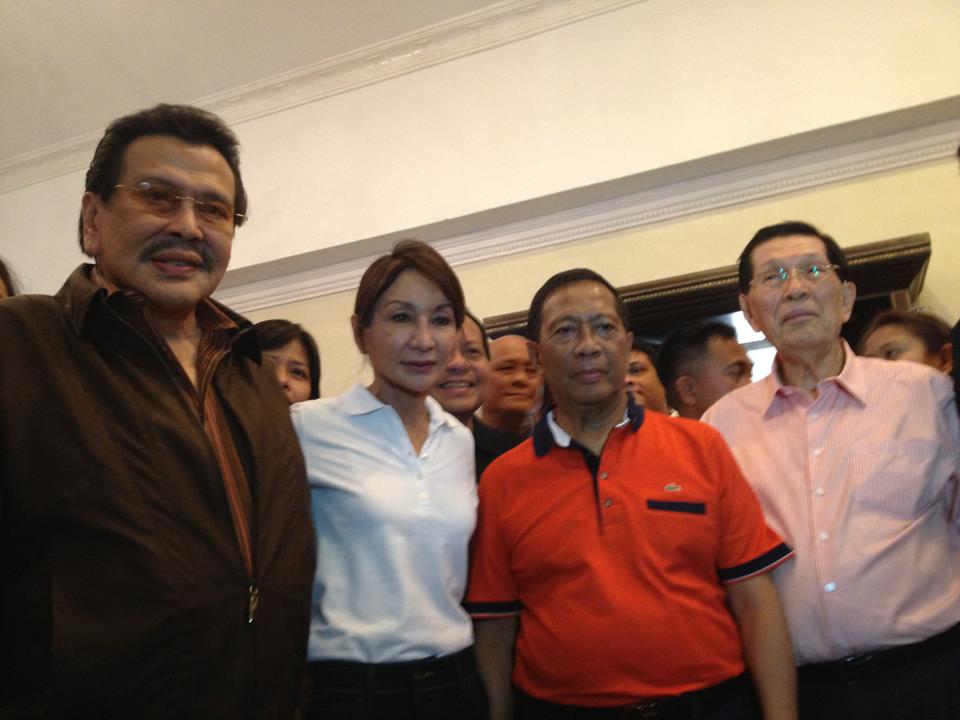Reversals of fortune: Gloria Arroyo and Joseph Estrada
The nation today marks the 27th anniversary of the 1986 EDSA People Power protests that toppled dictator Ferdinand Marcos. And since the current president is the scion of the family that benefited the most from EDSA 1986, the government of President Benigno Aquino III as well as the media will again surely lavish attention on this event (especially since 2013 is an election year).
This stands in clear opposite in the way the 12th anniversary of the 2001 EDSA People Power protests last month was treated by nearly everyone. The best way to illustrate how things have turned out in the twelve years since EDSA 2001 is by looking at the lives of the two leading dramatis personae’s in the event – Joseph Estrada and Gloria Macapagal-Arroyo.
On January 20, 2001, Arroyo took the oath of office as the 14th president of the Philippines with then-Chief Justice Hilario Davide. Though he physically vacated the Malacanang Palace aboard a barge that took him to his San Juan residence, Estrada insisted that he never resigned his post.
In a ruling promulgated six weeks after EDSA 2001, the Supreme Court stated that Estrada “constructively resigned” his post because of his statements and actions on that fateful day. Arroyo served out the final three years of Estrada’s term before winning another six-year mandate by beating Estrada’s bosom buddy, actor Fernando Poe Jr., in the 2004 presidential elections.

Estrada was found guilty of plunder by the Sandiganbayan in 2007, and was ultimately granted pardon by Arroyo a month after. Despite his legal woes, Estrada was able to flex his political muscles in all the national elections that followed his 2001 ouster. For some reason, his “Erap para sa mahirap” stuck. And better yet for Estrada, those who played a major role in EDSA 2001 openly expressed regret years later over how things eventually played out just like now-deceased former President Corazon Aquino.
Arroyo for her part retained slightly positive approval ratings in her first three years in office. Things took a turn for the worse in 2005, when the “Hello, Garci” scandal broke out. The following years didn’t get any better for the nation’s second woman president as allegations of massive corruption (NBN-ZTE deal, fertilizer fund scam, etc.) seriously challenged her administration. And as repeated in the media time and again, Arroyo left office in 2010 with the dubious distinction of being the country’s most unpopular president.
The reversal in the fate of Arroyo and Estrada is very evident in this election year. Following his surprise second place finish in the 2010 presidential race, Estrada is now challenging incumbent Alfredo Lim to be the mayor of the City of Manila.
Estrada is also one of the so-called “three kings” of the United Nationalist Alliance, the loosely-knit coalition challenging Liberal Party in the 2013 midterm polls. And because of his alliance with Vice President and 2016 presidential aspirant Jejomar Binay, his son Senator Jinggoy might be tapped as the latter’s running mate. Ergo, Estrada’s influence in Philippine politics may be felt for another decade or so.

If Estrada can take pride in being a kingmaker in all the national elections the past 15 years, the same cannot be said with Arroyo. One indicator of Arroyo’s enduring unpopularity is the fact that politicians, even from her own party, are reluctant to be associated with her.
In the lead-up to the 2007 midterm elections, current President Aquino, then a three-term representative from Tarlac, remarked: “This election is turning out to be a referendum on the Arroyo presidency and from the looks of it, her candidates are sure losers because of the kiss of death from you-know who.” And the elections validated his observation.
Of the twelve candidates running in the administration coalition that year, only two won. Miguel Zubiri, the initially proclaimed winner, resigned last 2011 amidst allegations of widespread cheating in Maguindanao. Three years ago, not one but two presidential candidates were derailed by perceived association to Arroyo – Gilbert Teodoro, her party’s official nominee, and Manuel Villar, her alleged secret candidate. In a survey last year by Pulse Asia, it was revealed that 82% of the respondents will not support candidates endorsed by Arroyo.
Estrada’s popularity continues to ride high, while Arroyo remains detained at the Veterans Memorial Medical Center. This is not to say that Estrada’s ouster in 2001 is wrong. Sandiganbayan’s verdict in 2007 proved that the allegations against him are factual. That Estrada was able to nearly win the presidency despite being ousted and convicted of plunder shows that winning perception is already half the battle. Meanwhile, it may take years before the cases against Arroyo get resolved but for now, things are looking good. (To be continued)







Every failure is a lesson well-learned
Every Success is a battle well-fought
So face hardships with courage.
i freaking don’t understand why ERAP is fuding allowed to run again. 🙁